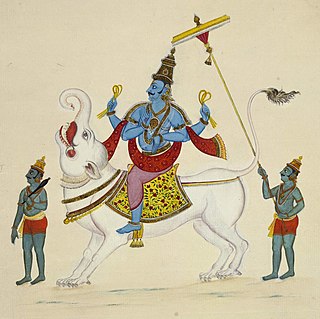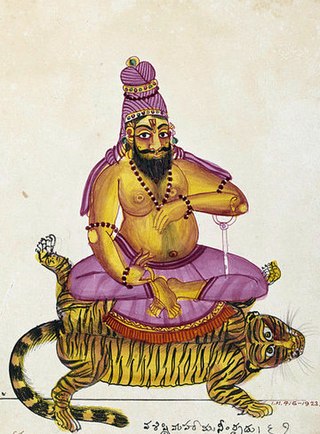
Varuna is a Hindu god, associated with the sky, oceans, and water. In the Vedic scriptures, he is paired with the god Mitra and is the lord of Ṛta (justice) and Satya (truth). Varuna is also mentioned as an Aditya, the sons of the goddess Aditi.

Hindu mythology is the body of myths attributed to, and espoused by, the adherents of the Hindu religion, found in Hindu texts such as the Vedas, the itihasa the Puranas, and mythological stories specific to a particular ethnolinguistic group like the Tamil Periya Puranam and Divya Prabandham, and the Mangal Kavya of Bengal. Hindu myths are also found in widely translated popular texts such as the fables of the Panchatantra and the Hitopadesha, as well as in Southeast Asian texts.

Varaha is an avatar of the Hindu god Vishnu, in the form of an Indian boar. Varaha is listed as third in the Dashavatara, the ten principal avatars of Vishnu.

Lakshmi also known as Shri, is one of the principal goddesses in Hinduism. She is the goddess of wealth, fortune, power, beauty, fertility and prosperity, and associated with Maya ("Illusion"). Along with Parvati and Saraswati, she forms the Tridevi of Hindu goddesses.

Agastya was a revered Indian sage of Hinduism. In the Indian tradition, he is a noted recluse and an influential scholar in diverse languages of the Indian subcontinent. He is regarded in some traditions to be a Chiranjivi. He and his wife Lopamudra are the celebrated authors of hymns 1.165 to 1.191 in the Sanskrit text Rigveda and other Vedic literature.

Avatar is a concept within Hinduism that in Sanskrit literally means 'descent'. It signifies the material appearance or incarnation of a powerful deity, or spirit on Earth. The relative verb to "alight, to make one's appearance" is sometimes used to refer to any guru or revered human being.

Narada, or Narada Muni, is a sage-divinity, famous in Hindu traditions as a travelling musician and storyteller, who carries news and enlightening wisdom. He is one of the mind-created children of Brahma, the creator god. He appears in a number of Hindu texts, notably the Mahabharata, telling Yudhishthira the story of Prahalada, and he also appears in the Ramayana and the Puranas. A common theme in Vaishnavism is the accompaniment of a number of deities such as Narada to offer aid to Vishnu upon his descent to earth to combat the forces of evil, or to enjoy a close view of epochal events. He is also referred to as Rishiraja, meaning the king of all sages. He was gifted with the boon of knowledge regarding the past, present, and the future.

Deva means "shiny", "exalted", "heavenly being", "divine being", "anything of excellence", and is also one of the Sanskrit terms used to indicate a deity in Hinduism. Deva is a masculine term; the feminine equivalent is Devi. The word is a cognate with Latin deus ("god") and Greek Zeus.

Perumal or Tirumal is a Hindu deity. Perumal is worshipped mainly among Tamil Hindus in South India and the Tamil diaspora, who consider Perumal to be a form of Vishnu.

The Smartatradition, also called Smartism, is a movement in Hinduism that developed and expanded with the Puranas genre of literature. It reflects a synthesis of four philosophical strands, namely Uttara Mīmāṃsā, Advaita, Yoga, and theism. The Smarta tradition rejects theistic sectarianism, and is notable for the domestic worship of five shrines with five deities, all treated as equal – Ganesha, Shiva, Shakti, Vishnu and Surya. The Smarta tradition contrasted with the older Shrauta tradition, which was based on elaborate rituals and rites. There has been a considerable overlap in the ideas and practices of the Smarta tradition with other significant historic movements within Hinduism, namely Shaivism, Brahmanism, Vaishnavism, and Shaktism.

Vasishtha is one of the oldest and revered Vedic rishis or sages, and one of the Saptarishis. Vasishtha is credited as the chief author of Mandala 7 of the Rigveda. Vasishtha and his family are mentioned in Rigvedic verse 10.167.4, other Rigvedic mandalas and in many Vedic texts. His ideas have been influential and he was called the first sage of the Vedanta school of Hindu philosophy by Adi Shankara.

Vaishnavism is one of the major Hindu denominations along with Shaivism, Shaktism, and Smartism. It is also called Vishnuism since it considers Vishnu as the sole supreme being leading all other Hindu deities, that is, Mahavishnu. Its followers are called Vaishnavites or Vaishnavas, and it includes sub-sects like Krishnaism and Ramaism, which consider Krishna and Rama as the supreme beings respectively. According to a 2010 estimate by Johnson and Grim, Vaishnavism is the largest Hindu sect, constituting about 641 million or 67.6% of Hindus.

Tamil mythology refers to the folklore and traditions that are a part of the wider Dravidian pantheon, originating from the Tamil people. This body of mythology is a fusion of elements from Dravidian culture and the parent Indus Valley culture, both of which have been syncretised with mainstream Hinduism.

The Dashavatara are the ten primary avatars of Vishnu, a principal Hindu god. Vishnu is said to descend in the form of an avatar to restore cosmic order. The word Dashavatara derives from daśa, meaning "ten", and avatāra, roughly equivalent to "incarnation".

Vishnu, also known as Narayana and Hari, is one of the principal deities of Hinduism. He is the supreme being within Vaishnavism, one of the major traditions within contemporary Hinduism.

In Hinduism, Adityas, refers to the offspring of Aditi, the goddess representing the infinity. The name Aditya, in the singular, is taken to refer to the sun god Surya. Generally, Adityas are twelve in number and consists of Vivasvan (Surya), Aryaman, Tvashta, Savitr, Bhaga, Dhata, Mitra, Varuna, Amsa, Pushan, Indra and Vishnu.
Hinduism in Tamil Nadu finds its earliest literary mention in the Sangam literature dated to the 5th century BCE. The total number of Tamil Hindus as per 2011 Indian census is 63,188,168 which forms 87.58% of the total population of Tamil Nadu. Hinduism is the largest religion in Tamil Nadu.

Over the millennia of its development, Hinduism has adopted several iconic symbols, forming part of Hindu iconography, that are imbued with spiritual meaning based on either the scriptures or cultural traditions. The exact significance accorded to any of the icons varies with region, period and denomination of the followers. Over time some of the symbols, for instance the Swastika has come to have wider association while others like Om are recognized as unique representations of Hinduism. Other aspects of Hindu iconography are covered by the terms murti, for icons and mudra for gestures and positions of the hands and body.

Tamil Hindus are the Tamil-speaking people who follow Hinduism.
















